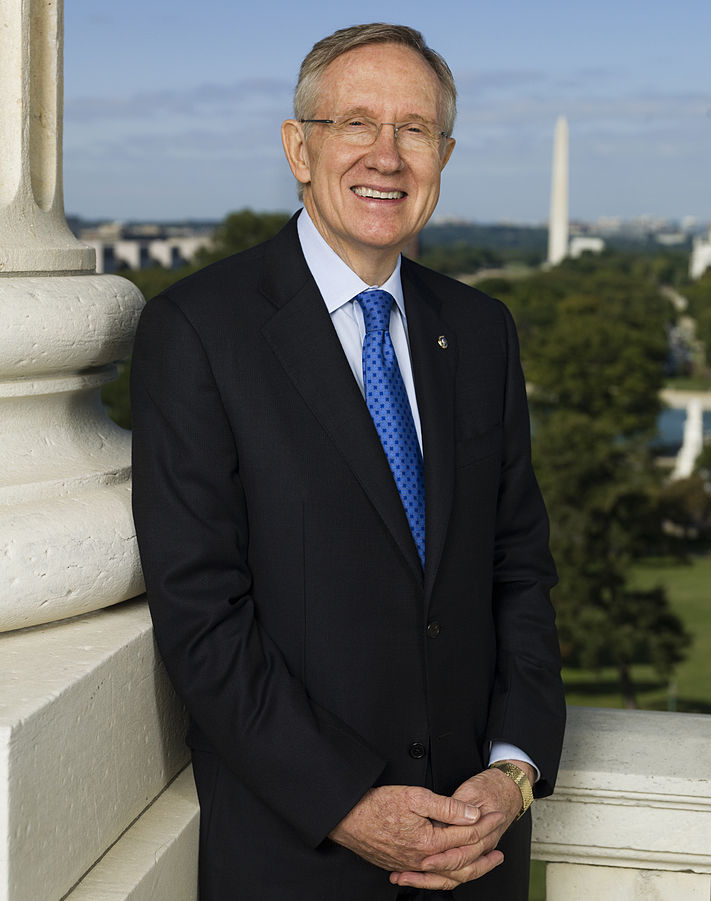
LAS VEGAS — Harry Reid may no longer lead Senate Democrats in Washington, but the political machine he built in Nevada has Republicans on the run.
Democrats romped up and down the state in the Nov. 6 midterm elections, ousting Republican Sen. Dean Heller, winning races for governor and lieutenant governor, and expanding their state legislative majorities.
The shellacking was 15 years in the making, the culmination of a long-term plan to shift a battleground into the Democratic column. Democrats elsewhere will work to replicate Nevada for years to come. Republicans were humbled.
“These things can change, but right now Nevada is a blue state,” said Mark Hutchison, the state’s outgoing Republican lieutenant governor. “There’s no doubt that the Democratic Party has done a very good job in Nevada of getting out the vote and creating an infrastructure that is formidable.”
The political mastermind behind the Democrats’ ascendency is 78-year-old Harry Reid, the soft-spoken former Senate majority leader who served for decades in Washington before his retirement last year. Despite being treated for pancreatic cancer, Reid has remained active in Nevada politics.
Reid started building the state party for the 2004 election, when Nevada was in a tug of war between its Western libertarian roots and the Democratic leanings of recent transplants. The party had no permanent staff in nonelection years; now it has double digits.
Senate Republicans had sent him a warning shot that November by ousting his predecessor as Democratic leader, Sen. Tom Daschle of South Dakota. That led Reid to step up efforts to protect his home flank. He helped make Nevada’s caucuses one of the first-in-the-nation presidential contests and a destination for political spending by national aspirants.
“It didn’t really matter that his name wasn’t on the ballot, he was all in every day,” said Rebecca Lambe, a longtime Reid aide and Democratic strategist.
Reid used the national cash flowing in to build a strong state Democratic Party and bolster a network of pro-immigrant and environmental organizations. They worked with Las Vegas’ potent unions to power a Democratic turnout machine.
“This is what Democrats need to be doing everywhere. This is the long game,” said Rebecca Katz, a Democratic strategist and former Reid staffer.
Not everything Reid built may be easily exportable.
Nevada has only about 3 million residents, so it’s easy for left-leaning groups to co-ordinate and have an impact. Most voters are concentrated in Clark County, which includes Las Vegas. It’s a state full of demographic groups that lean Democratic, with 29 per cent of its population Latino and only 49 per cent white.
Las Vegas’ economy generates lots of working-class, service jobs that can’t be outsourced, making it easier for unions to organize. Most significantly, it’s given birth to the Culinary Union, a 57,000-member political force representing casino workers that helps pad Democratic margins with its voter turnout programs.
But Nevada Democrats do face obstacles.
They can only win statewide if they turn out Las Vegas’ transient and diverse workforce. This was one of Reid’s epiphanies in 2004, Lambe said. “There was a recognition that the electorate didn’t reflect the population of the state.”
One solution was nonstop voter registration to keep catching new arrivals and adding them to the voter rolls. Doing that, and then turning those hard-to-reach voters out, takes money.
Reid is a prolific fundraiser who has been able to keep money flowing to the state. But there is a grim example for Democrats of what can happen when that spigot runs dry.
In 2014, Reid turned his attention to trying to save Democratic control of the Senate in races outside Nevada. There was no competitive race for governor or Senate to draw Nevada voters’ interest. Door-knocking and voter registration in Las Vegas dwindled. Republicans swept all statewide races, even winning a congressional seat in the heart of Democratic Las Vegas that was called the “Culinary District” because the union had such sway there.
This year, Reid helped pick candidates and staff for important races and raised money. It’s hard to quantify how the machine is funded because money flows through many different organizations. One measure is that Heller had $35 million spent against him by outside groups, as opposed to $20 million for Democratic opponent, Rep. Jacky Rosen.
“The ‘Reid Machine’ is synonymous with money,” said Jeremy Hughes, a Republican strategist who advised Heller’s campaign. “It totally is a resources issue. People believe the Republican Party is the party of large special interests when it is in fact the Democrat Party that had 30 outside special interest groups on the ground. Republicans did not have that.”
Nevada Democrats worry that national donors may be overly secure that the state has gone Democratic and they may be less inclined to invest there in 2020, when there is no Senate race on the ballot.
“The question is, are Democrats going to be able to raise the money when we don’t have a top-of-the-ticket governor and a top-of-the-ticket Senate race,” said Andres Ramirez, a Democratic strategist in Las Vegas and a former Reid staffer.
Reid’s hand-picked successor in the Senate, former state Attorney General Catherine Cortez Masto, is supposed to take his place as chief organizer and fundraiser for the state’s Democrats. Last week, she was named head of the Democratic Senatorial Campaign Committee and will oversee the party’s 2020 Senate races. It’s a job that will connect her with many big national donors. But Cortez Masto cannot match Reid’s Senate tenure and connections.
Reid didn’t attend the Democrats’ election night celebration at Caesar’s Palace in Las Vegas, but he texted and called former aides to keep up. “He was very happy,” Lambe said, “and proud.”